Comprehensive Characteristics of Summer Deep Convection over Tibetan Plateau and Its South Slope from the Global Precipitation Measurement Core Observatory
Abstract
:1. Introduction
2. Data and Methods
2.1. Data
2.2. Methods
- For every pixel with the precipitation echo, the maximum corrected reflective factor (MaxCRF) in the radar beam must exceed the threshold of 39 dBZ. The threshold value of 39 dBZ means that the intensity of precipitation is sufficient to distinguish the non-convection precipitation pixels [49].
- The maximum height of the 20 dBZ radar echo (Maxht20) of the convection precipitation pixel must exceed 14 km. 14 km is usually regarded as the base of the tropopause layer [50]. If the convective cloud top exceeds this height, then the convection will affect the upper troposphere and the lower stratosphere. The convection pixel satisfying the above criteria is defined as a deep convection pixel.
- Adjacent deep convection pixels in the same track are regarded as a DCS. The maximum value of Maxht20 among these pixels is used to represent the intensity and location of the DCS.
3. Results
3.1. Frequency of DCSs
3.2. Spatial Distribution of DCSs
3.3. Diurnal Variation in DCSs
3.4. Vertical Structure of DCSs
4. Discussion and Conclusions
- There was a higher frequency of DCSs over the SS (0.98%) than that over the TP (0.15%). Convective precipitation accounted for 65.43% of the summer precipitation over the TP, but was generally is shallow and weak. The ratio of strong and deep convection over the TP is less than that over SS.
- The DCSs over the TP and SS mainly occurred in July–August. The DCSs concentrat in the eastern TP and SS in June. Whereas in July and August, more DCSs were generated in the central to eastern region of TP and in the west of SS.
- There was a clear diurnal variation in DCSs over both the TP and SS. The two sub-regions both showed the highest number of DCSs in the afternoon, but the greatest difference was seen during the night, when DCSs were rarely generated over the TP. The mean intensity of DCSs precipitation over the SS was lower than that over the TP.
- Five different radar echo heights were used to compare the structure of the deep convective core over the TP and SS. The mean cloud-top heights of DCSs over the TP and SS were 15.9 and 16.1 km, respectively. The mean maximum echo values of DCSs over the TP and SS were 44.2 and 50.2 dBZ, respectively. The area of deep convection over the TP was shorter and weaker than that over the SS.
Author Contributions
Funding
Acknowledgments
Conflicts of Interest
References
- Grossman, R.L.; Garcia, O. The distribution of deep convection over ocean and land during the Asian summer monsoon. J. Clim. 1990, 3, 1032–1044. [Google Scholar] [CrossRef]
- Ramanathan, V.; Cess, R.; Harrison, E.; Minnis, P.; Barkstrom, B.; Ahmad, E.; Hartmann, D. Cloud-radiative forcing and climate-Results from the Earth Radiation Budget Experiment. Science 1989, 243, 57–63. [Google Scholar] [CrossRef] [PubMed]
- Holton, J.R.; Haynes, P.H.; McIntyre, M.E.; Douglass, A.R.; Rood, R.B.; Pfister, L. Stratosphere-troposphere exchange. Rev. Geophys. 1995, 33, 403–439. [Google Scholar] [CrossRef]
- Sherwood, S.C.; Dessler, A.E. On the control of stratospheric humidity. Geophys. Res. Lett. 2000, 27, 2513–2516. [Google Scholar] [CrossRef] [Green Version]
- Bhatt, B.C.; Koh, T.-Y.; Yamamoto, M.; Nakamura, K. The diurnal cycle of convective activity over South Asia as diagnosed from METEOSAT-5 and TRMM data. Terr. Atmos. Ocean. Sci. 2010, 21, 841–854. [Google Scholar] [CrossRef]
- Christian, H.J.; Blakeslee, R.J.; Boccippio, D.J.; Boeck, W.L.; Buechler, D.E.; Driscoll, K.T.; Goodman, S.J.; Hall, J.M.; Koshak, W.J.; Mach, D.M. Global frequency and distribution of lightning as observed from space by the Optical Transient Detector. J. Geophys. Res. Atmos. 2003, 108, ACL 4-1–ACL 4-15. [Google Scholar] [CrossRef]
- Liu, C.; Zipser, E.J. Global distribution of convection penetrating the tropical tropopause. J. Geophys. Res. Atmos. 2005, 110. [Google Scholar] [CrossRef] [Green Version]
- Liu, C.; Zipser, E.J.; Nesbitt, S.W. Global distribution of tropical deep convection: Different perspectives from TRMM infrared and radar data. J. Clim. 2007, 20, 489–503. [Google Scholar] [CrossRef]
- Qie, X.; Wu, X.; Yuan, T.; Bian, J.; Lu, D. Comprehensive pattern of deep convective systems over the Tibetan Plateau–South Asian monsoon region based on TRMM data. J. Clim. 2014, 27, 6612–6626. [Google Scholar] [CrossRef]
- Zipser, E.J.; Cecil, D.J.; Liu, C.; Nesbitt, S.W.; Yorty, D.P. Where are the most intense thunderstorms on Earth? Bull. Am. Meteorol. Soc. 2006, 87, 1057–1071. [Google Scholar] [CrossRef]
- Ding, Y.; Wang, Z.; Sun, Y. Inter-decadal variation of the summer precipitation in East China and its association with decreasing Asian summer monsoon. Part I: Observed evidences. Int. J. Clim. 2008, 28, 1139–1161. [Google Scholar] [CrossRef]
- Xu, X.; Lu, C.; Shi, X.; Gao, S. World water tower: An atmospheric perspective. Geophys. Res. Lett. 2008, 35. [Google Scholar] [CrossRef] [Green Version]
- Xu, X.; Shi, X.; Wang, Y.; Peng, S.; Shi, X. Data analysis and numerical simulation of moisture source and transport associated with summer precipitation in the Yangtze River Valley over China. Meteorol. Atmos. Phys. 2008, 100, 217–231. [Google Scholar] [CrossRef]
- Duan, A.; Wu, G. Role of the Tibetan Plateau thermal forcing in the summer climate patterns over subtropical Asia. Clim. Dyn. 2005, 24, 793–807. [Google Scholar] [CrossRef]
- Flohn, H. Large-scale aspects of the “summer monsoon” in South and East Asia. J. Meteorol. Soc. Jpn. Ser. II 1957, 35, 180–186. [Google Scholar] [CrossRef]
- Hoskins, B.J.; Karoly, D.J. The steady linear response of a spherical atmosphere to thermal and orographic forcing. J. Atmos. Sci. 1981, 38, 1179–1196. [Google Scholar] [CrossRef]
- Solomon, S.; Rosenlof, K.H.; Portmann, R.W.; Daniel, J.S.; Davis, S.M.; Sanford, T.J.; Plattner, G.-K. Contributions of stratospheric water vapor to decadal changes in the rate of global warming. Science 2010, 327, 1219–1223. [Google Scholar] [CrossRef]
- Tian, W.; Chipperfield, M.; Huang, Q. Effects of the Tibetan Plateau on total column ozone distribution. Tellus B 2008, 60, 622–635. [Google Scholar] [CrossRef] [Green Version]
- Wu, G.; Zhang, Y. Tibetan Plateau forcing and the timing of the monsoon onset over South Asia and the South China Sea. Mon. Weather Rev. 1998, 126, 913–927. [Google Scholar] [CrossRef]
- Yeh, T. The circulation of the high troposphere over China in the winter of 1945–46. Tellus 1950, 2, 173–183. [Google Scholar] [CrossRef]
- Fu, R.; Hu, Y.; Wright, J.S.; Jiang, J.H.; Dickinson, R.E.; Chen, M.; Filipiak, M.; Read, W.G.; Waters, J.W.; Wu, D.L. Short circuit of water vapor and polluted air to the global stratosphere by convective transport over the Tibetan Plateau. Proc. Natl. Acad. Sci. USA 2006, 103, 5664–5669. [Google Scholar] [CrossRef] [Green Version]
- Li, Q.; Jiang, J.H.; Wu, D.L.; Read, W.G.; Livesey, N.J.; Waters, J.W.; Zhang, Y.; Wang, B.; Filipiak, M.J.; Davis, C.P. Trapping of Asian pollution by the Tibetan anticyclone: A global CTM simulation compared with EOS MLS observations. Geophys. Res. Lett. 2005, 32, L14826. [Google Scholar] [CrossRef]
- Park, M.; Randel, W.J.; Gettelman, A.; Massie, S.T.; Jiang, J.H. Transport above the Asian summer monsoon anticyclone inferred from Aura Microwave Limb Sounder tracers. J. Geophys. Res. Atmos. 2007, 112. [Google Scholar] [CrossRef] [Green Version]
- Randel, W.J.; Park, M.; Emmons, L.; Kinnison, D.; Bernath, P.; Walker, K.A.; Boone, C.; Pumphrey, H. Asian monsoon transport of pollution to the stratosphere. Science 2010, 328, 611–613. [Google Scholar] [CrossRef] [PubMed]
- Sun, Y.; Chen, Q.; Gui, K.; Dong, F.; Feng, X.; Long, Q. Characteristics of Water Vapor in the UTLS over the Tibetan Plateau Based on AURA/MLS Observations. Adv. Meteorol. 2017, 2017, 3504254. [Google Scholar] [CrossRef]
- Solomon, S.; Daniel, J.S.; Neely, R.R.; Vernier, J.-P.; Dutton, E.G.; Thomason, L.W. The persistently variable “background” stratospheric aerosol layer and global climate change. Science 2011, 333, 866–870. [Google Scholar] [CrossRef] [PubMed]
- Kirk-Davidoff, D.B.; Hintsa, E.J.; Anderson, J.G.; Keith, D.W. The effect of climate change on ozone depletion through changes in stratospheric water vapour. Nature 1999, 402, 399–401. [Google Scholar] [CrossRef]
- Oltmans, S.; Hofmann, D. Increase in lower-stratospheric water vapour at a mid-latitude Northern Hemisphere site from 1981 to 1994. Nature 1995, 374, 146–149. [Google Scholar] [CrossRef]
- Smith, C.A.; Toumi, R.; Haigh, J.D. Seasonal trends in stratospheric water vapour. Geophys. Res. Lett. 2000, 27, 1687–1690. [Google Scholar] [CrossRef] [Green Version]
- Randel, W.J.; Park, M. Deep convective influence on the Asian summer monsoon anticyclone and associated tracer variability observed with Atmospheric Infrared Sounder (AIRS). J. Geophys. Res. Atmos. 2006, 111. [Google Scholar] [CrossRef] [Green Version]
- Highwood, E.; Hoskins, B. The tropical tropopause. Q. J. R. Meteorol. Soc. 1998, 124, 1579–1604. [Google Scholar] [CrossRef]
- Folkins, I.; Loewenstein, M.; Podolske, J.; Oltmans, S.J.; Proffitt, M. A barrier to vertical mixing at 14 km in the tropics: Evidence from ozonesondes and aircraft measurements. J. Geophys. Res. Atmos. 1999, 104, 22095–22102. [Google Scholar] [CrossRef] [Green Version]
- Houze, R.A.; Wilton, D.C.; Smull, B.F. Monsoon convection in the Himalayan region as seen by the TRMM Precipitation Radar. Q. J. R. Meteorol. Soc. 2007, 133, 1389–1411. [Google Scholar] [CrossRef]
- Xu, W. Precipitation and convective characteristics of summer deep convection over East Asia observed by TRMM. Mon. Weather Rev. 2013, 141, 1577–1592. [Google Scholar] [CrossRef]
- Long, Q.; Chen, Q.; Gui, K.; Zhang, Y. A Case Study of a Heavy Rain over the Southeastern Tibetan Plateau. Atmosphere 2016, 7, 118. [Google Scholar] [CrossRef]
- Romatschke, U.; Houze, R.A., Jr. Characteristics of precipitating convective systems in the South Asian monsoon. J. Hydrometeorol. 2011, 12, 3–26. [Google Scholar] [CrossRef]
- Romatschke, U.; Medina, S.; Houze, R.A., Jr. Regional, seasonal, and diurnal variations of extreme convection in the South Asian region. J. Clim. 2010, 23, 419–439. [Google Scholar] [CrossRef]
- Luo, Y.; Zhang, R.; Qian, W.; Luo, Z.; Hu, X. Intercomparison of deep convection over the Tibetan Plateau–Asian monsoon region and subtropical North America in boreal summer using CloudSat/CALIPSO data. J. Clim. 2011, 24, 2164–2177. [Google Scholar] [CrossRef]
- Iwasaki, S.; Shibata, T.; Nakamoto, J.; Okamoto, H.; Ishimoto, H.; Kubota, H. Characteristics of deep convection measured by using the A-train constellation. J. Geophys. Res. Atmos. 2010, 115. [Google Scholar] [CrossRef] [Green Version]
- Iwasaki, S.; Shibata, T.; Okamoto, H.; Ishimoto, H.; Kubota, H. Mixtures of stratospheric and overshooting air measured using A-Train sensors. J. Geophys. Res. Atmos. 2012, 117. [Google Scholar] [CrossRef] [Green Version]
- Sassen, K.; Wang, Z.; Liu, D. Cirrus clouds and deep convection in the tropics: Insights from CALIPSO and CloudSat. J. Geophys. Res. Atmos. 2009, 114. [Google Scholar] [CrossRef] [Green Version]
- Takahashi, H.; Luo, Z.J. Characterizing tropical overshooting deep convection from joint analysis of CloudSat and geostationary satellite observations. J. Geophys. Res. Atmos. 2014, 119, 112–121. [Google Scholar] [CrossRef] [Green Version]
- Stephens, G.L.; Vane, D.G.; Boain, R.J.; Mace, G.G.; Sassen, K.; Wang, Z.; Illingworth, A.J.; O’connor, E.J.; Rossow, W.B.; Durden, S.L. The CloudSat mission and the A-Train: A new dimension of space-based observations of clouds and precipitation. Bull. Am. Meteorol. Soc. 2002, 83, 1771–1790. [Google Scholar] [CrossRef]
- Hou, A.Y.; Kakar, R.K.; Neeck, S.; Azarbarzin, A.A.; Kummerow, C.D.; Kojima, M.; Oki, R.; Nakamura, K.; Iguchi, T. The global precipitation measurement mission. Bull. Am. Meteorol. Soc. 2014, 95, 701–722. [Google Scholar] [CrossRef]
- Liu, N.; Liu, C. Global distribution of deep convection reaching tropopause in 1 year GPM observations. J. Geophys. Res. Atmos. 2016, 121, 3824–3842. [Google Scholar] [CrossRef]
- Maussion, F.; Scherer, D.; Mölg, T.; Collier, E.; Curio, J.; Finkelnburg, R. Precipitation seasonality and variability over the Tibetan Plateau as resolved by the High Asia Reanalysis. J. Clim. 2014, 27, 1910–1927. [Google Scholar] [CrossRef]
- Singh, D.; Tsiang, M.; Rajaratnam, B.; Diffenbaugh, N.S. Observed changes in extreme wet and dry spells during the South Asian summer monsoon season. Nat. Clim. Chang. 2014, 4, 456–461. [Google Scholar] [CrossRef]
- Turner, A.G.; Annamalai, H. Climate change and the South Asian summer monsoon. Nat. Clim. Chang. 2012, 2, 587–595. [Google Scholar] [CrossRef]
- Le, M.; Chandrasekar, V. Precipitation type and profile classification for GPM-DPR. In Proceedings of the 2011 IEEE International Geoscience and Remote Sensing Symposium (IGARSS), Vancouver, BC, Canada, 24–29 July 2011; pp. 1275–1278. [Google Scholar]
- Fueglistaler, S.; Dessler, A.; Dunkerton, T.; Folkins, I.; Fu, Q.; Mote, P.W. Tropical tropopause layer. Rev. Geophys. 2009, 47. [Google Scholar] [CrossRef] [Green Version]
- Yeh, T. The thermal structure, convective activity over Qinghai-Tibetan Plateau in summer and their interactions with large-scale circulation. Chin. J. Atmos. Sci. 1988, 12, 1–12. (In Chinese) [Google Scholar]
- Xu, X.-D.; Chen, L.-S. Advances of the study on Tibetan Plateau experiment of atmospheric sciences. J. Appl. Meteorol. Sci. 2006, 17, 756–772. [Google Scholar]
- Cetrone, J.; Houze, R.A. Anvil clouds of tropical mesoscale convective systems in monsoon regions. Q. J. R. Meteorol. Soc. 2009, 135, 305–317. [Google Scholar] [CrossRef] [Green Version]
- Fu, Y.; Liu, G. Possible misidentification of rain type by TRMM PR over Tibetan Plateau. J. Appl. Meteorol. Clim. 2007, 46, 667–672. [Google Scholar] [CrossRef]
- Fu, Y.F.; Pan, X.; Liu, G.; Li, R.; Zhong, L. Characteristics of precipitation based on cloud brightness temperatures and storm tops in summer over the Tibetan Plateau. Chin. J. Atmos. Sci. 2016, 40, 102–120. [Google Scholar]
- Fu, Y.; Liu, Q.; Zi, Y.; Feng, S.; Li, Y.; Liu, G. Summer precipitation and latent heating over the Tibetan Plateau based on TRMM measurements. Plateau Mt. Meteorol. Res. 2008, 1, 001. [Google Scholar]
- Yang, K.; Koike, T.; Fujii, H.; Tamura, T.; Xu, X.; Bian, L.; Zhou, M. The daytime evolution of the atmospheric boundary layer and convection over the Tibetan Plateau: Observations and simulations. J. Meteorol. Soc. Jpn. Ser. II 2004, 82, 1777–1792. [Google Scholar] [CrossRef]
- Uyeda, H.; Yamada, H.; Horikomi, J.; Shirooka, R.; Shimizu, S.; Liping, L.; Ueno, K.I.; Fujii, H.; Koike, T. Characteristics of convective clouds observed by a Doppler radar at Naqu on Tibetan Plateau during the GAME-Tibet IOP. J. Meteorol. Soc. Jpn. Ser. II 2001, 79, 463–474. [Google Scholar] [CrossRef]
- Jiang, J.; Fan, M. Convective Clouds and Mesoscale Convective Systems over the Tibetan Plateau in Summer. Chin. J. Atmos. Sci. 2002, 2, 011. [Google Scholar]
- Chen, B.; Xu, X.; Yang, S.; Zhao, T. Climatological perspectives of air transport from atmospheric boundary layer to tropopause layer over Asian monsoon regions during boreal summer inferred from Lagrangian approach. Atmos. Chem. Phys. 2012, 12, 5827–5839. [Google Scholar] [CrossRef] [Green Version]
- McCarthy, M.; Boering, K.; Rahn, T.; Eiler, J.; Rice, A.; Tyler, S.; Schauffler, S.; Atlas, E.; Johnson, D. The hydrogen isotopic composition of water vapor entering the stratosphere inferred from high-precision measurements of δD-CH4 and δD-H2. J. Geophys. Res. Atmos. 2004, 109. [Google Scholar] [CrossRef]
- Khaykin, S.; Pommereau, J.-P.; Korshunov, L.; Yushkov, V.; Nielsen, J.; Larsen, N.; Christensen, T.; Garnier, A.; Lukyanov, A.; Williams, E. Hydration of the lower stratosphere by ice crystal geysers over land convective systems. Atmos. Chem. Phys. 2009, 9, 2275–2287. [Google Scholar] [CrossRef] [Green Version]
- Gray, W.M.; Jacobson, R.W. Diurnal variation of deep cumulus convection. Mon. Weather Rev. 1977, 105, 1171–1188. [Google Scholar] [CrossRef]
- Chen, L.; Song, Y.; Liu, J.; Wang, W. On the Diurnal Variation of Convection over Qinghai-Xizang Plateau During Summer as Revealed from Meteorological Satellite Data. Acta Meteorol. Sin. 1999, 5, 004. [Google Scholar]
- Fujinami, H.; Nomura, S.; Yasunari, T. Characteristics of diurnal variations in convection and precipitation over the southern Tibetan Plateau during summer. Sola 2005, 1, 49–52. [Google Scholar] [CrossRef]
- Dai, A. Global precipitation and thunderstorm frequencies. Part II: Diurnal variations. J. Clim. 2001, 14, 1112–1128. [Google Scholar] [CrossRef]
- Carbone, R.E.; Tuttle, J.D.; Ahijevych, D.A.; Trier, S.B. Inferences of Predictability Associated with Warm Season Precipitation Episodes. J. Atmos. Sci. 2002, 59, 2033–2056. [Google Scholar] [CrossRef]
- He, H.; Zhang, F. Diurnal Variations of Warm-Season Precipitation over Northern China. Mon. Weather Rev. 2010, 138, 1017–1025. [Google Scholar] [CrossRef]
- Barros, A.P.; Lang, T.J. Monitoring the monsoon in the Himalayas: Observations in central Nepal, June 2001. Mon. Weather Rev. 2003, 131, 1408–1427. [Google Scholar] [CrossRef]
- Bhatt, B.C.; Nakamura, K. Characteristics of monsoon rainfall around the Himalayas revealed by TRMM precipitation radar. Mon. Weather Rev. 2005, 133, 149–165. [Google Scholar] [CrossRef]
- Battaglia, A.; Tanelli, S.; Mroz, K.; Tridon, F. Multiple scattering in observations of the GPM dual-frequency precipitation radar: Evidence and impact on retrievals. J. Geophys. Res. Atmos. 2015, 120, 4090–4101. [Google Scholar] [CrossRef] [Green Version]

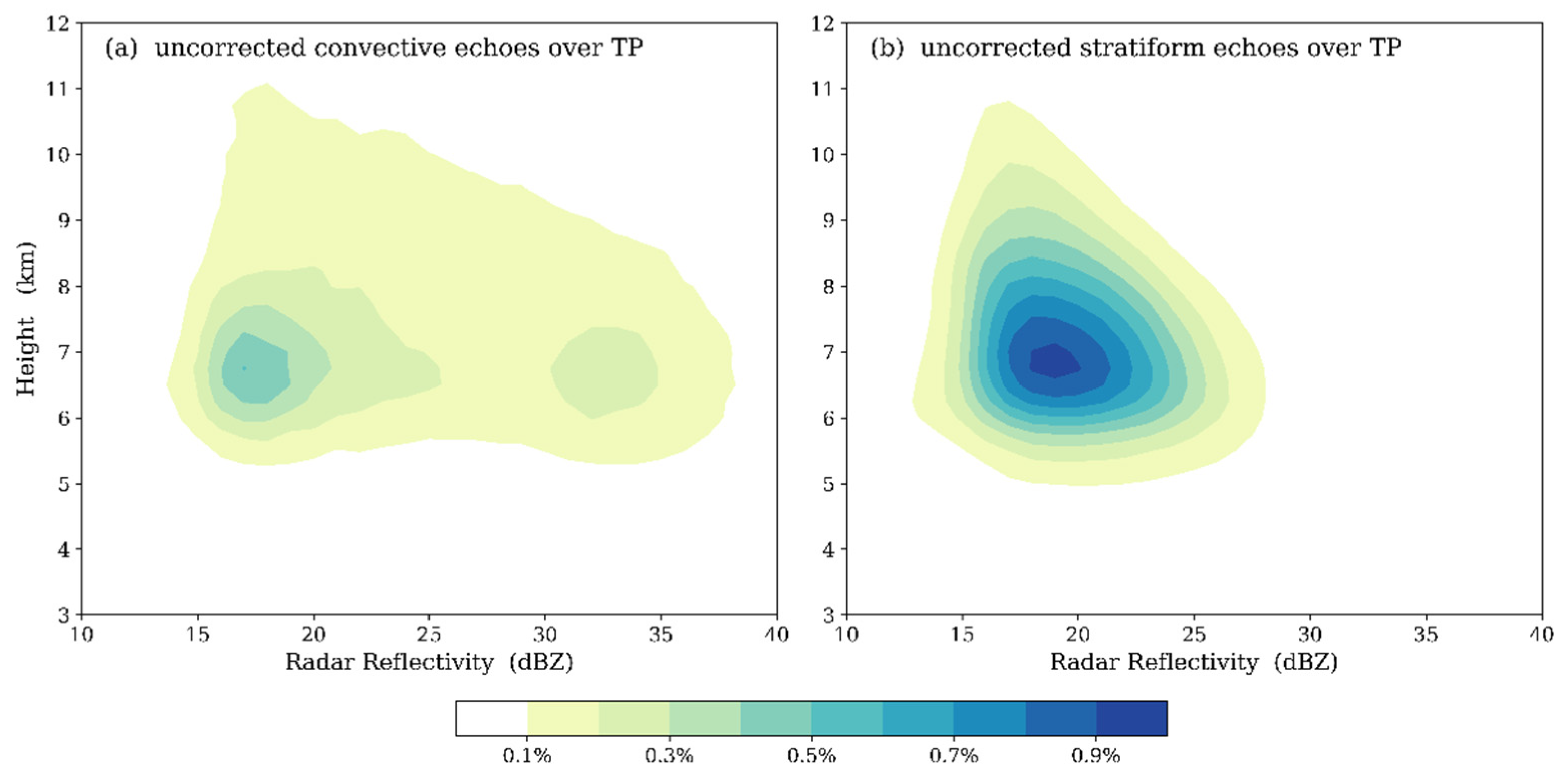
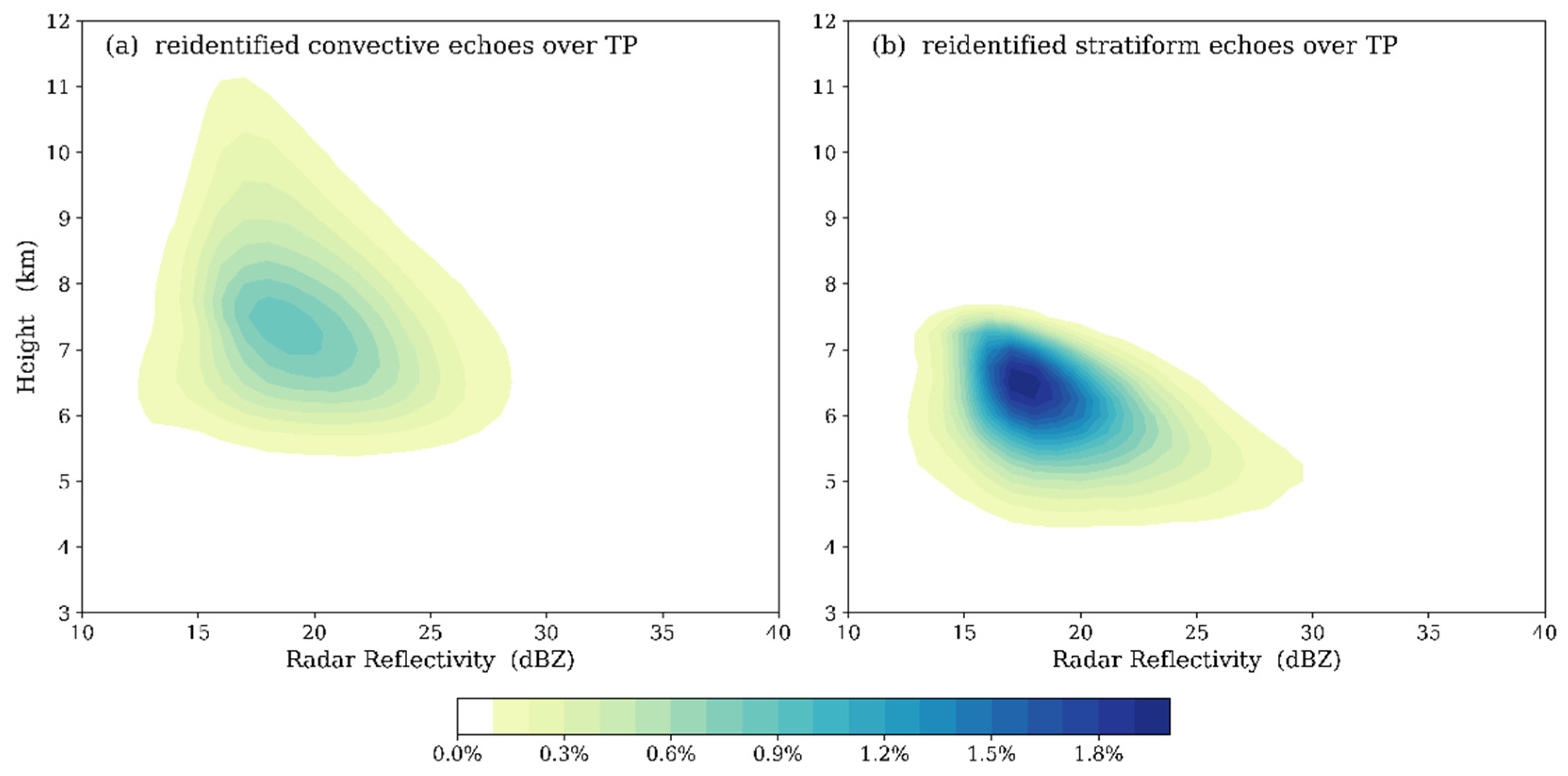


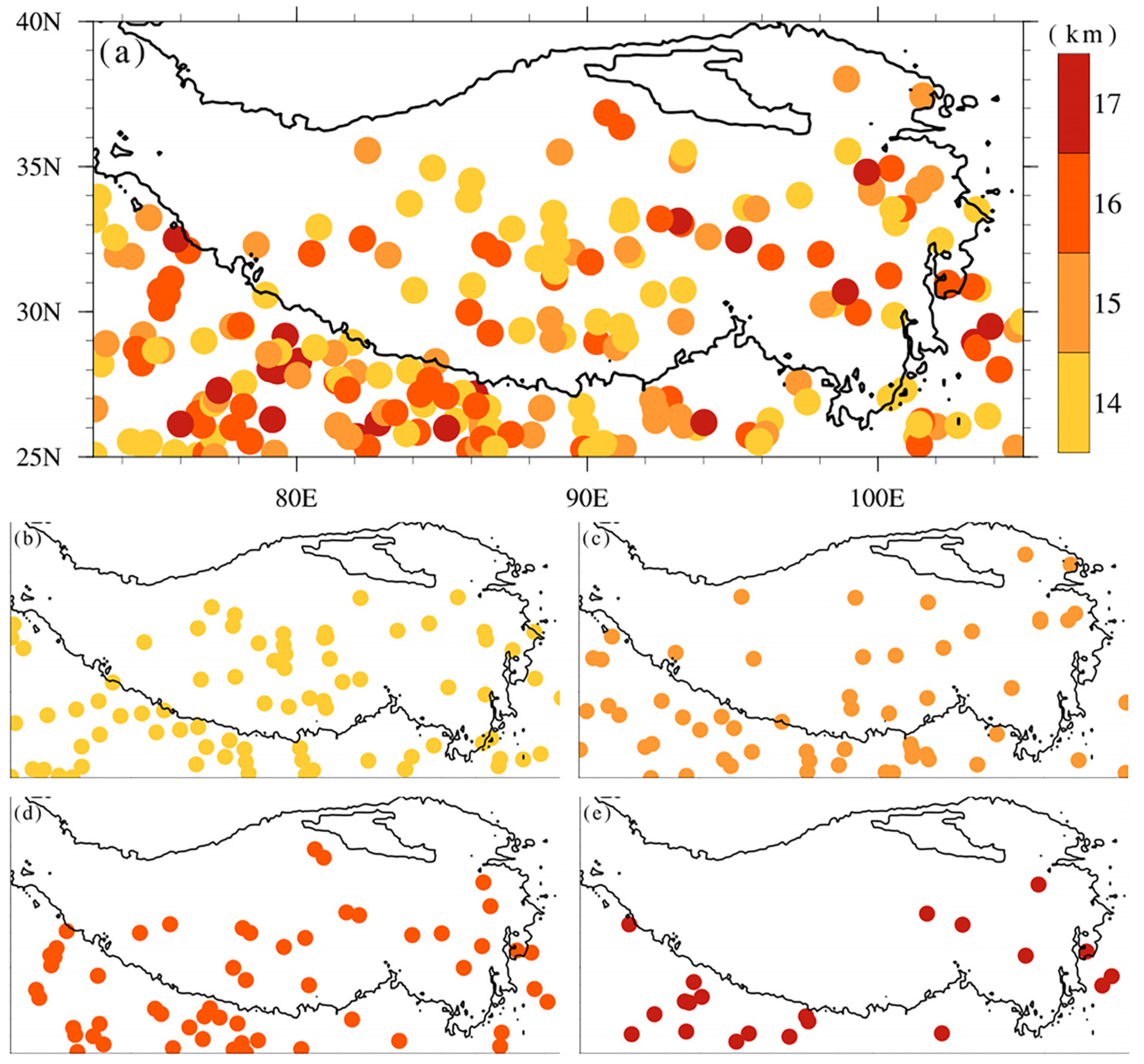
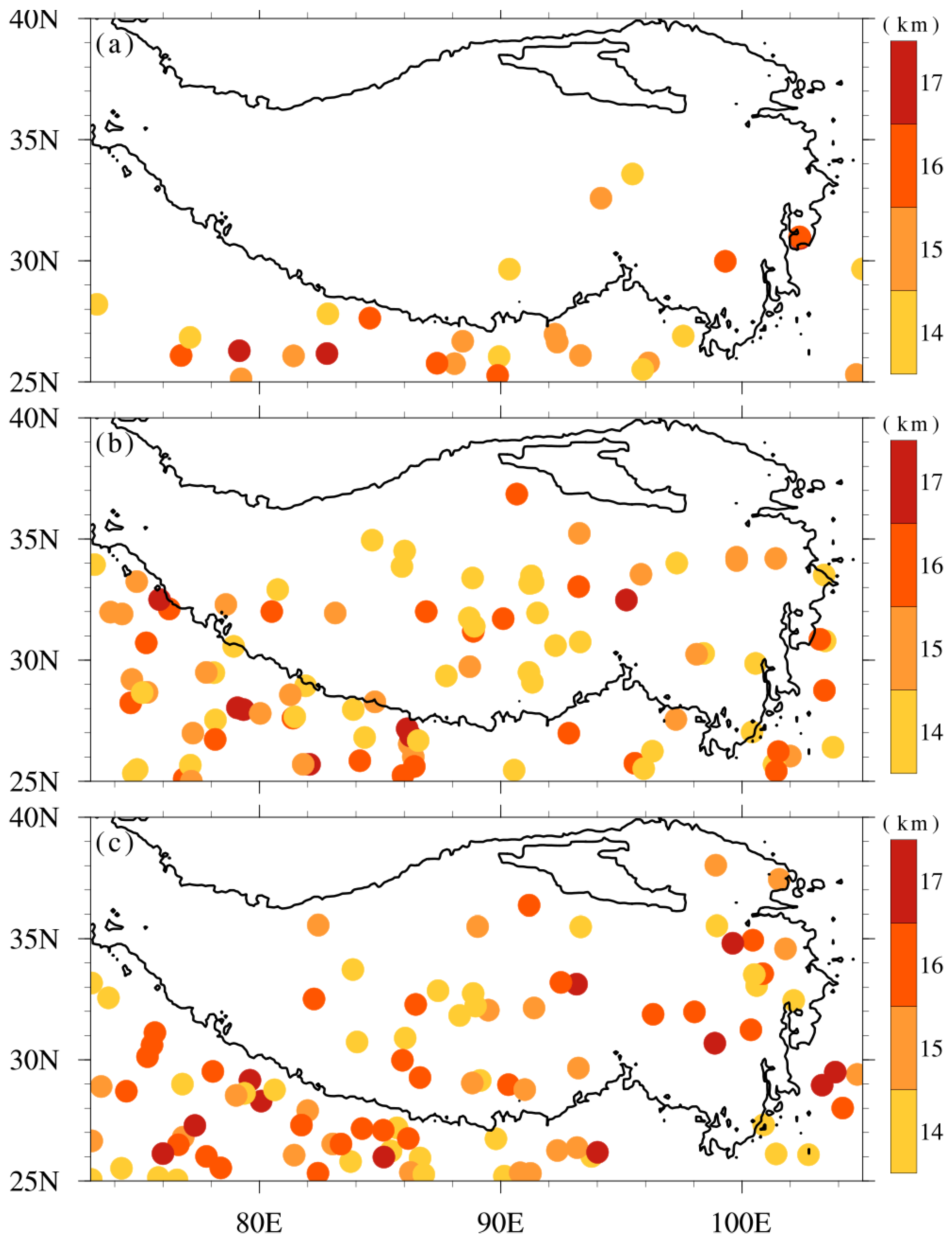


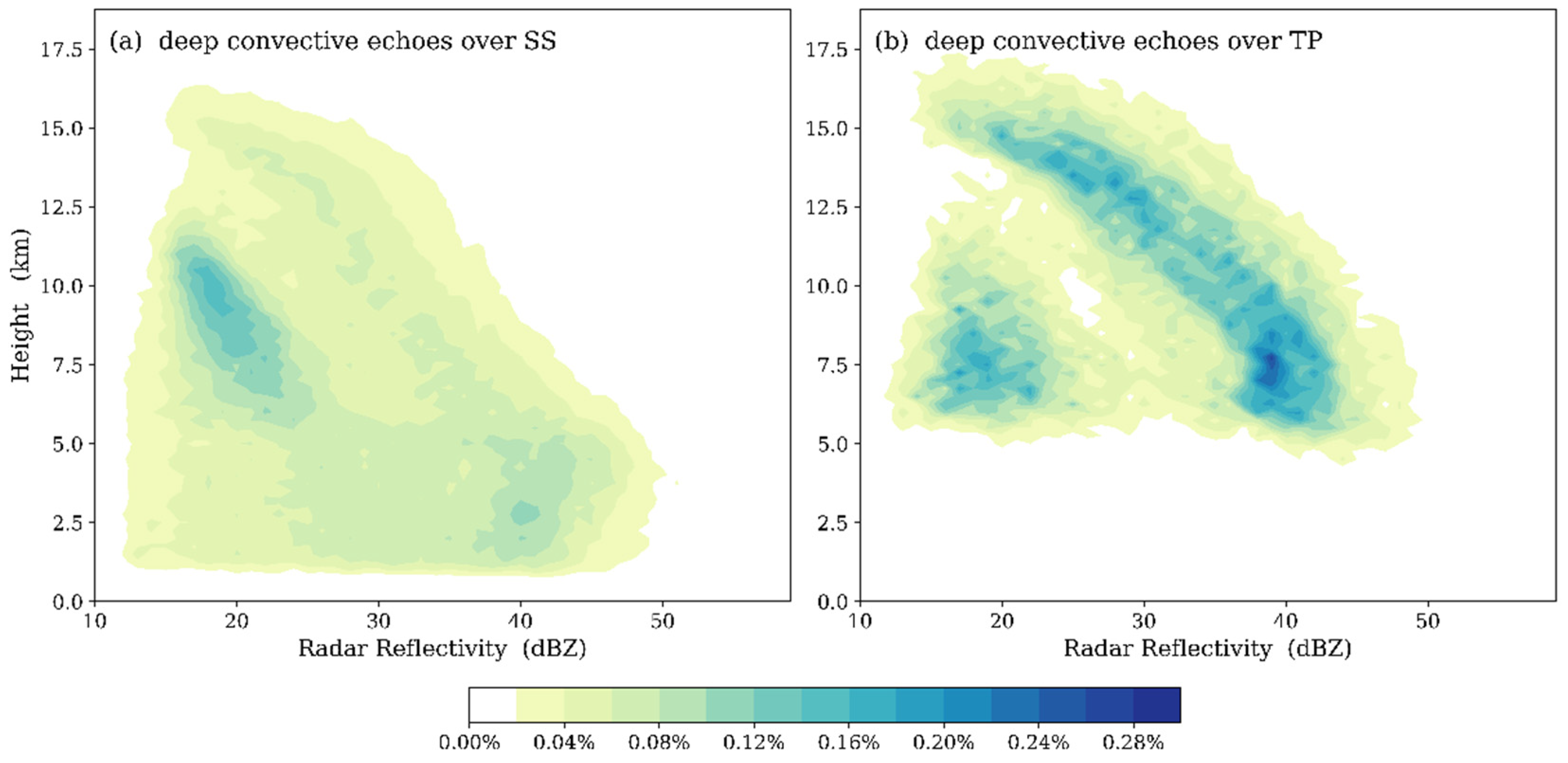

| Type | Total | Convection | Stratiform | Other |
|---|---|---|---|---|
| Total numbers (%) of pixels | 729,622 | 124,364 (17.04) | 529,901 (72.63) | 75,357 (10.33) |
| Mean intensity of precipitation (mm/h) | 1.421097 | 3.987779 | 1.016497 | 0.030321 |
| Total number (%) of pixels over the TP | 333,854 (45.76) | 28,093 (8.41) | 274,158 (82.11) | 31,603 (9.47) |
| Mean intensity of precipitation over the TP (mm/h) | 0.963609 | 3.276923 | 0.8339 | 0.032456 |
| Total number (%) pixels over the SS | 395,768 (54.24) | 96,271 (24.33) | 255,743 (64.62) | 43,754 (11.06) |
| Mean intensity of precipitation over the SS (mm/h) | 1.807016 | 4.195215 | 1.212242 | 0.028779 |
| Type | Total | Convection Uncorrected | Convection Corrected | Deep Convection |
|---|---|---|---|---|
| Total number (%) of pixels | 729,622 | 124,364 (17.04) | 314,707 (43.13) | 1.265 (0.40) |
| Mean intensity of precipitation (mm/h) | 1.421097 | 3.987779 | 2.072498 | 21.83921 |
| Total number (%) of pixels over the TP | 333,854 (45.76) | 28,093 (8.41) | 218,436 (65.43) | 322 (0.15) |
| Mean intensity of precipitation over the TP (mm/h) | 0.963609 | 3.276923 | 1.136956 | 21.21894 |
| Total number (%) of pixels over the SS | 395,768 (54.24) | 96,271 (24.33) | 96,271 (24.32) | 943 (0.98) |
| Mean intensity of precipitation over the SS (mm/h) | 1.807016 | 4.195215 | 4.195215 | 22.05101 |
© 2019 by the authors. Licensee MDPI, Basel, Switzerland. This article is an open access article distributed under the terms and conditions of the Creative Commons Attribution (CC BY) license (http://creativecommons.org/licenses/by/4.0/).
Share and Cite
Gao, G.; Chen, Q.; Cai, H.; Li, Y.; Wang, Z. Comprehensive Characteristics of Summer Deep Convection over Tibetan Plateau and Its South Slope from the Global Precipitation Measurement Core Observatory. Atmosphere 2019, 10, 9. https://doi.org/10.3390/atmos10010009
Gao G, Chen Q, Cai H, Li Y, Wang Z. Comprehensive Characteristics of Summer Deep Convection over Tibetan Plateau and Its South Slope from the Global Precipitation Measurement Core Observatory. Atmosphere. 2019; 10(1):9. https://doi.org/10.3390/atmos10010009
Chicago/Turabian StyleGao, Guolu, Quanliang Chen, Hongke Cai, Yang Li, and Zhenglin Wang. 2019. "Comprehensive Characteristics of Summer Deep Convection over Tibetan Plateau and Its South Slope from the Global Precipitation Measurement Core Observatory" Atmosphere 10, no. 1: 9. https://doi.org/10.3390/atmos10010009
APA StyleGao, G., Chen, Q., Cai, H., Li, Y., & Wang, Z. (2019). Comprehensive Characteristics of Summer Deep Convection over Tibetan Plateau and Its South Slope from the Global Precipitation Measurement Core Observatory. Atmosphere, 10(1), 9. https://doi.org/10.3390/atmos10010009





